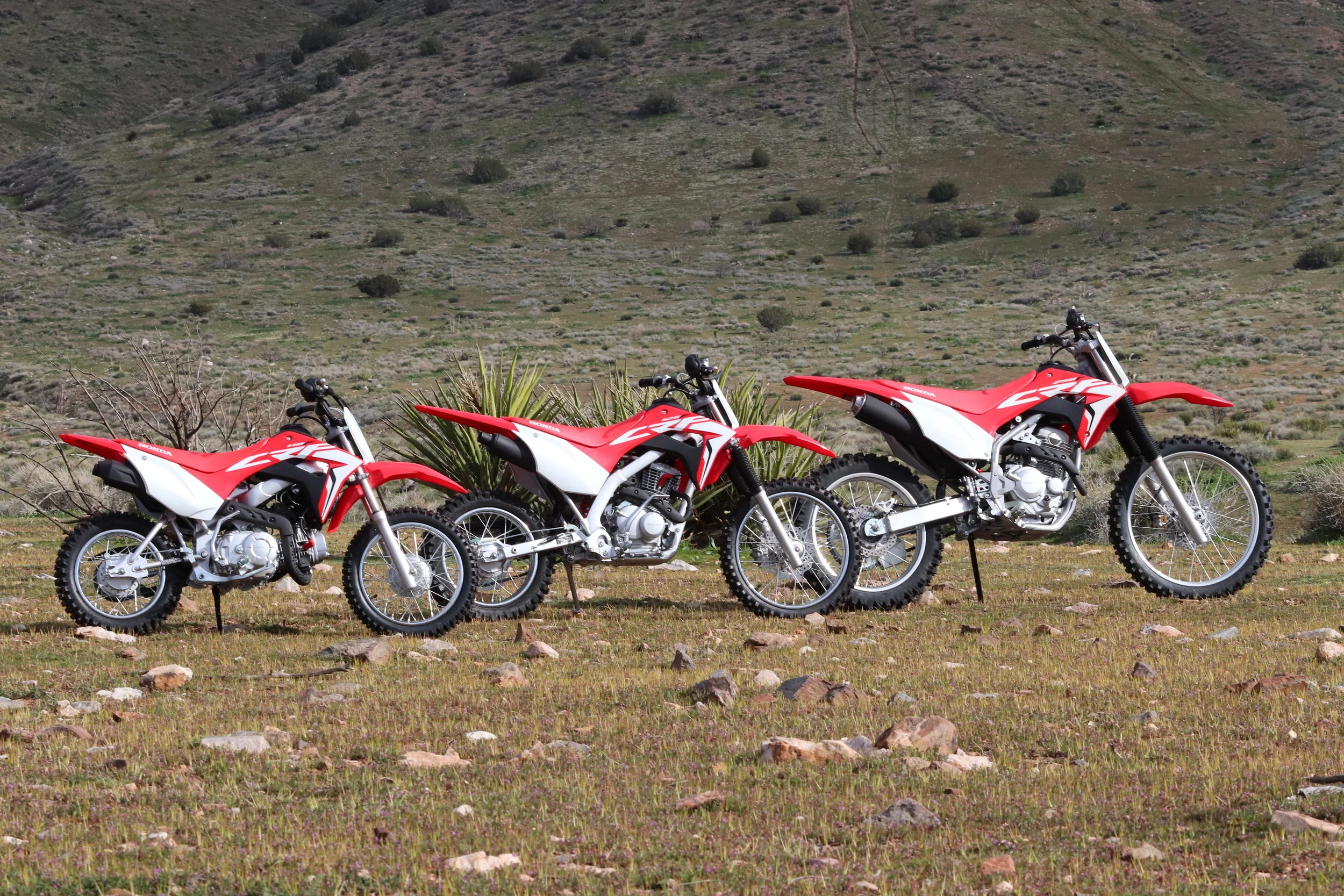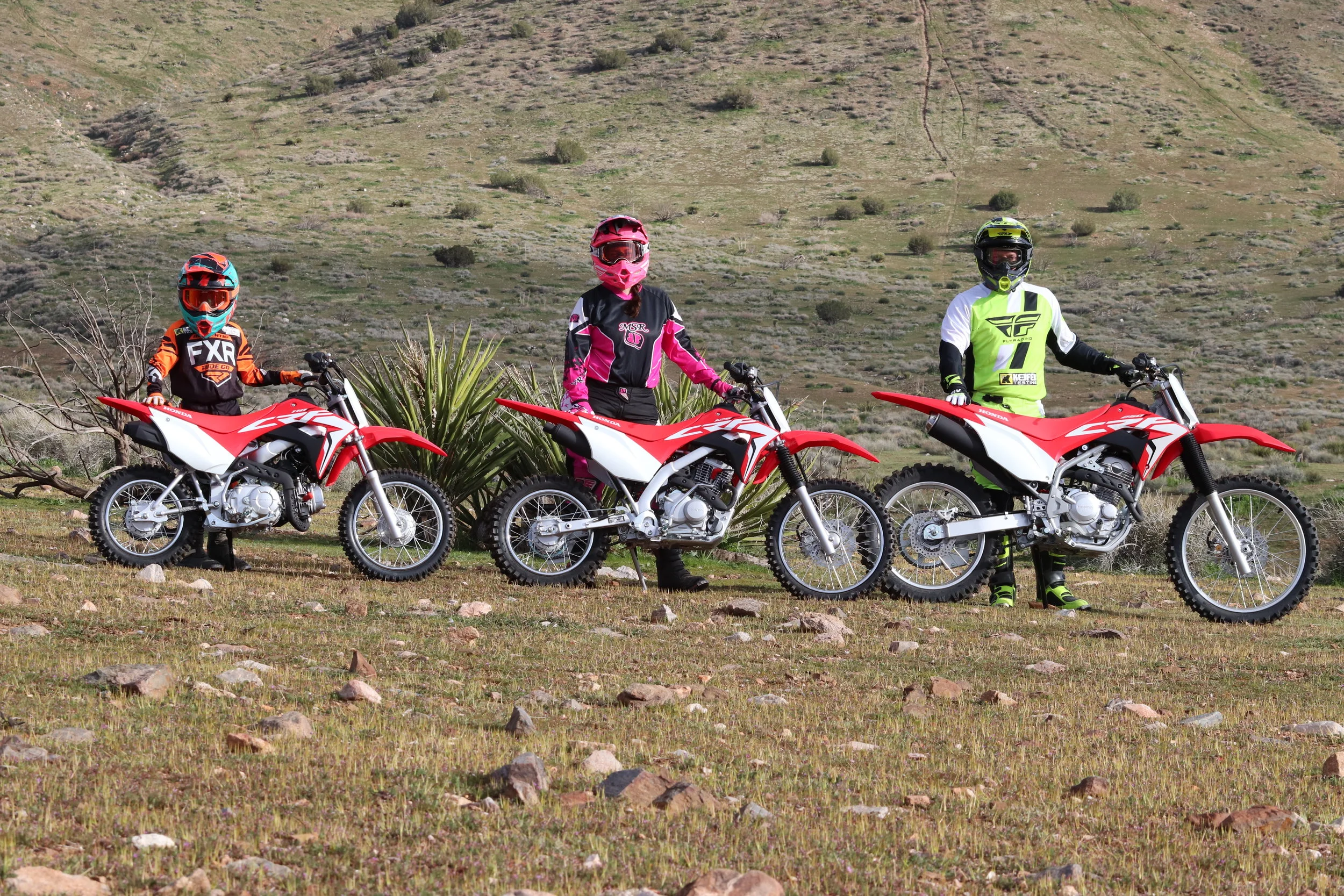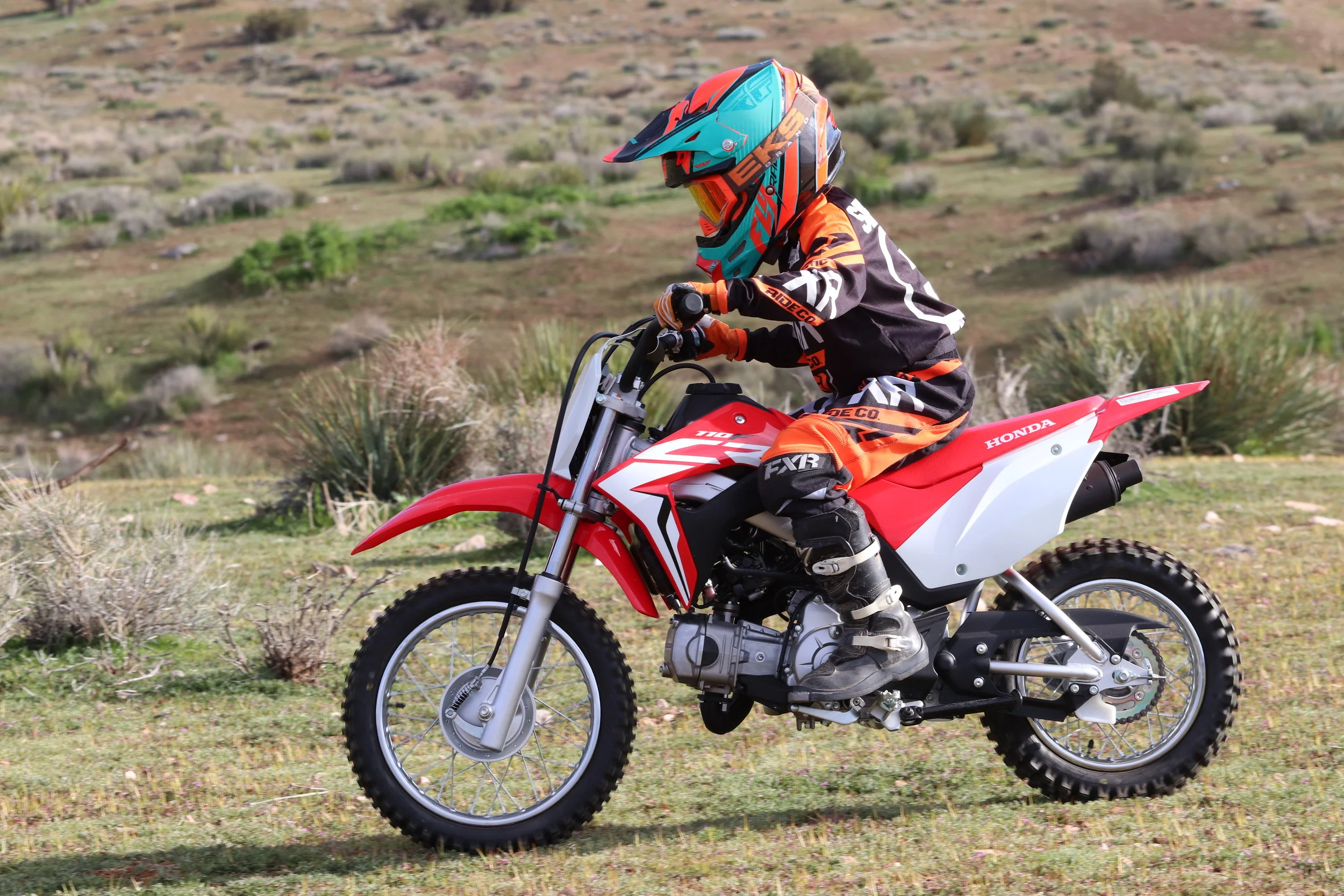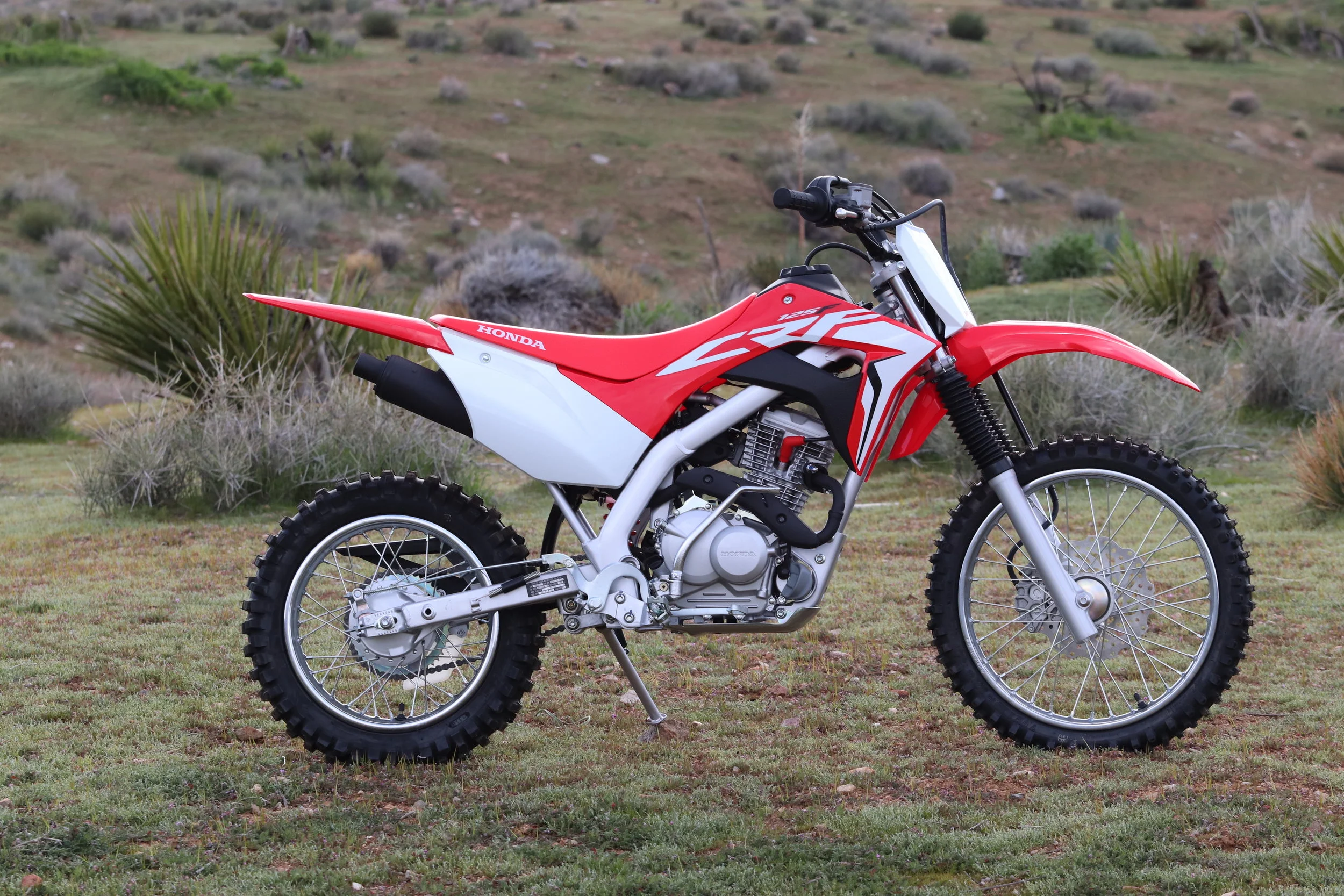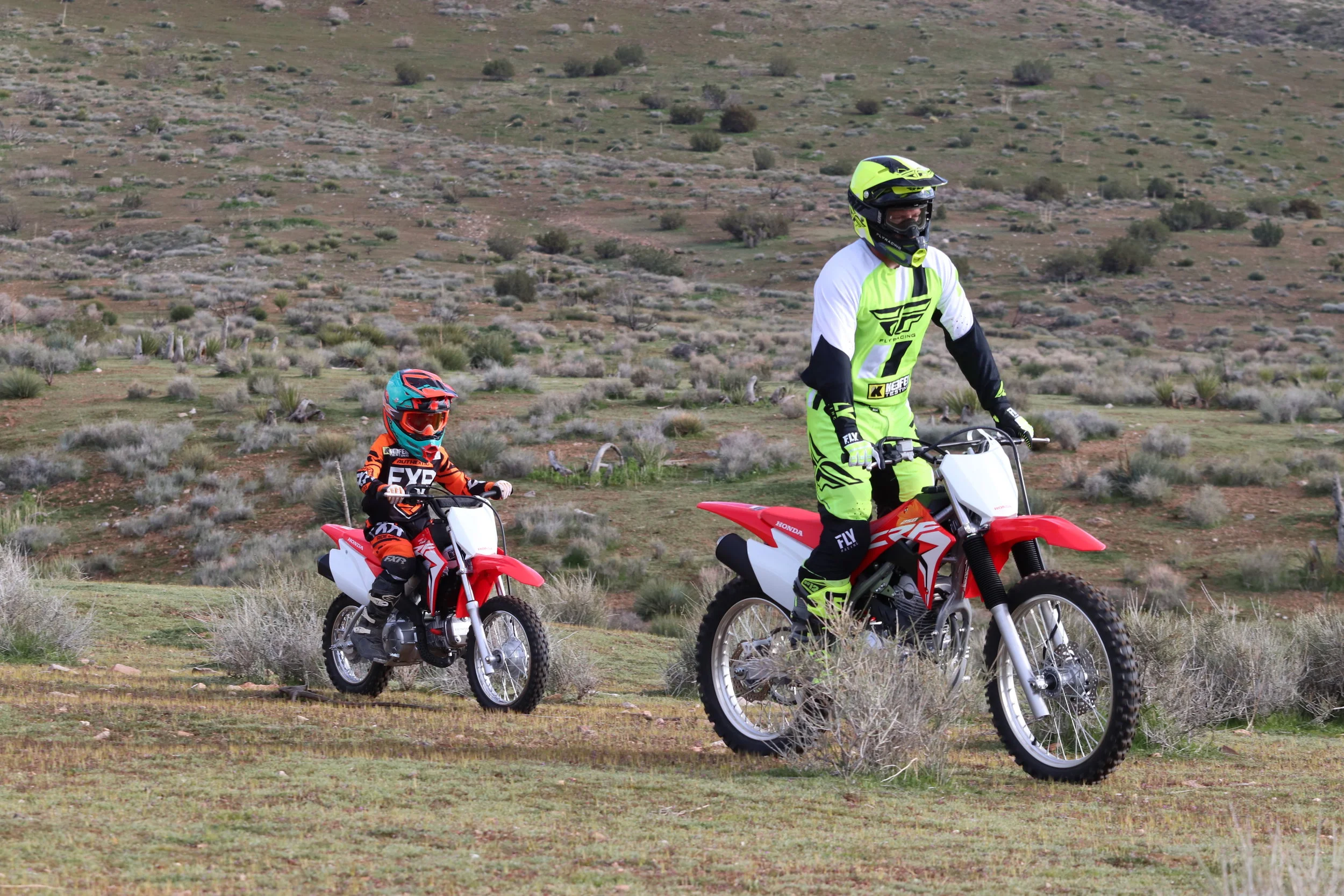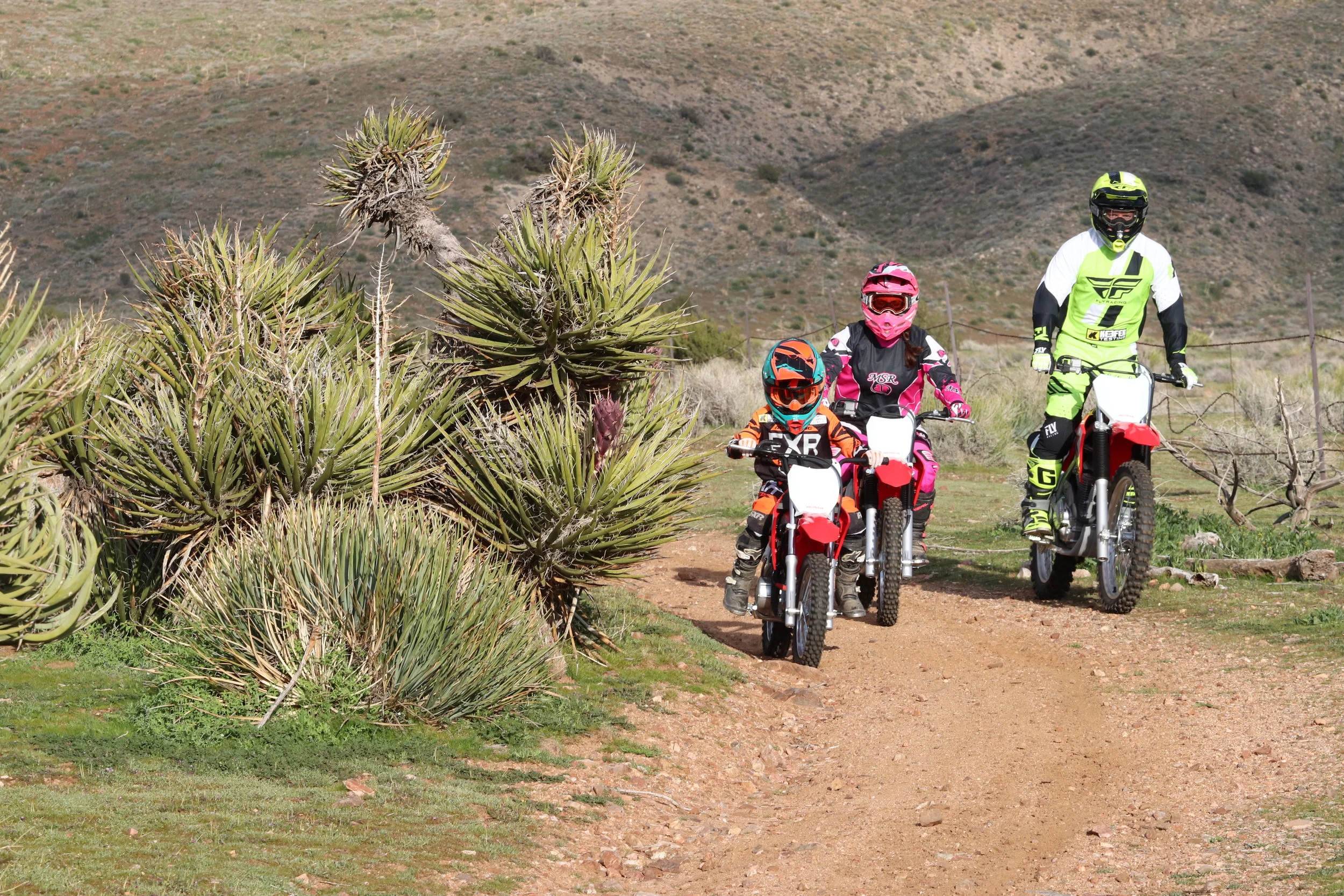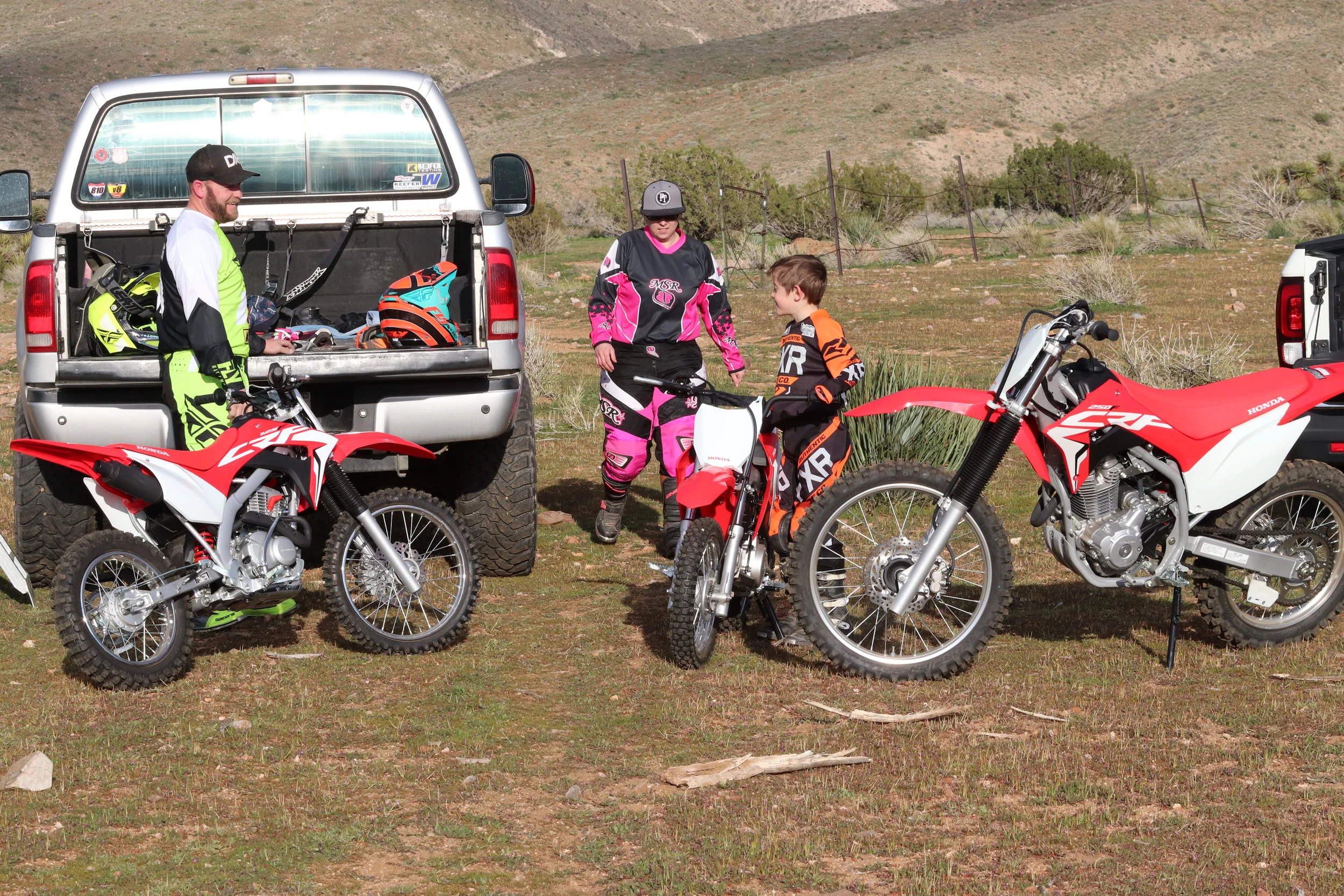Some of my fondest memories that I have as a child was riding with my parents in the desert on the weekends. I remember sitting in class daydreaming about heading to the desert to ride my motorcycle and wishing it was Friday evening so we could pack up and head out. Not only was it great to spend time with my family, it also programmed my young mind on what I wanted in life. Once the teenage years did hit me, I wasn't all about partying and getting into trouble. Instead, without me even knowing, riding with my parents at a young age gave me a passion that kept me out of trouble later in life. Living in the hight desert, trouble can find you without you even asking for it. Dirt bikes kept me on the straight and narrow and some of that directly has to do with Honda providing trail bikes that my family chose to purchase. Getting more families and kids off their phones and out to OHV areas to ride is important for the health of our sport. If the basic “learn to ride bikes” aren't here for these potential new consumers/families (and all we have is the advanced technology going into the bigger more advanced machines) than our sport is doomed.
Fast forward to 2019 and Honda has put some of that modern technology into their CRF trail bike lineup. Gone are the days of kickstarting and jetting your Honda trail bike, not to mention they even look like the bigger more racier CRF motocross machines. What about the cost of the newer technology driving these trail bikes up? I understand that cost is an issue with every middle class family, but coming from that kind of family, I know that having these advancements can help roll these types of bikes over to newer/younger generations, without much needed maintenance. I learned how to ride on a second generation Honda trail bike and I could only wish I would of had fuel injection (among other modern upgrades) on mine. Chances would of been high that my son would have learned on the same bike that I did. I can see these types of newer Honda trail bikes getting passed down from even further generations because of the advancements that Honda has put into their trail line.
We recently had a chance to take delivery of the 2019 Honda CRF110F, CRF125F, and CRF250F and we gave those machines to a family (that is relatively new to the sport) so that they could enjoy a couple weekends out in the desert to ride these fun new “Ride Red” machines. Below is a breakdown of each machine, what changed for 2019, which family member “tested” which machine, weight/age/size of rider, and their ability. Also stay tuned for a special Keefer Tested Podcast that will be going over these Honda trail bikes and how a family like the Sirevaag’s used these models to enjoy some quality family time.
CRF110F $2,399.00: Landon Sirevaag/8 years old/new rider/4’1/60 lbs.
Overview: For 2019, this model features a Keihin electronic fuel-injection system that’s tuned for linear power delivery and precise throttle response, and is 50-state off-road legal. The easier-to-use power is matched to an all-new steel twin-spar frame that’s engineered with CRF Performance Line DNA but extensively tested and developed for the right balance of precision and comfort for recreational riders. The smooth power delivery and nimble chassis function together to offer a secure ride. The new CRF110F carries over its four-speed, clutch-less transmission for takeoffs and shifting that quickly become comfortable for every rider. An additional 12mm of rear-suspension travel and a 5mm increase in seat-foam thickness (without increasing overall seat height) mean improved comfort whether sitting or standing. And of course the CRF110F delivers Honda’s legendary build quality and reliability, so the bike dependably fires up every time the starter button is pressed and doesn’t stop until the tank runs dry—and when that moment is looming, the FI system provides a low-fuel warning light. A big benefit for the young rider’s “factory mechanic” is that the fuel-injection system eliminates the possibility of carburetor jets clogging with fuel residue if the motorcycle sits for an extended period—and reduced maintenance means more family time on the trail or track. The CRF110F boasts top-level performance in a small package—just like its rider.
2019 Updates
Follows technology developments of CRF Performance Line with Keihin electronically controlled fuel-injection system that delivers linear and hesitation-free power, minimizing intimidation for new riders and providing a friendly power delivery for all levels. Fuel-injection system delivers smooth power at all rpm and all throttle openings.
Twin-spar steel frame, inspired by the CRF Performance Line frame architecture, provides the right balance of rigidity and comfort.
New frame and 12mm increase in rear-suspension travel let this small bike handle the bigger bumps with better control and reduced bottoming.
New seat foam is 5mm thicker, yet bike maintains same overall seat height of previous model due to seat placement in the new frame.
New 1 gallon steel fuel tank with integrated fuel pump incorporates built-in fuel filter and low-fuel indicator on handlebar (lights up at .2 gallons remaining). New frame design shields tank in the event of a fall.
All-new bodywork with CRF Performance Line styling and graphics.
New handlebar-mounted multiple-function handlebar switch incorporates starter button, ignition “key on” indicator, fuel-injection system status, and “low fuel” indicator light (replaces reserve setting on petcock).
New ratchet-style fuel-tank cap reduces possibility of loosening during ride.
Half-waffle grips have a smaller circumference for an improved fit with smaller hands.
Engine / Drivetrain
Air-cooled single-cylinder four-stroke 109cc engine tuned for new riders.
Four-speed gearbox with automatic clutch.
Adjustable throttle-limiter screw to match rider abilities.
Convenient electric starter with kick-start backup.
Chassis / Suspension
Low seat height of only 26.3 inches.
Handlebar pad.
Meets current EPA and CARB off-road emissions standards.
Rider Opinion: I just started riding and am learning how to ride on a KTM 50 SX. I still don’t know how to use a clutch, but I want to learn soon. I like that this bike is fun and not as loud as my KTM 50 because I feel like I can think more when I ride. I can start this bike on my own unlike my KTM 50 where I have to have my dad start it for me. Following my dad on trails or riding the kids track at local motocross tracks seems like more fun to me on the Honda. I can also ride the 110F around my backyard without making my neighbors too mad! The Honda is a little bigger than my KTM, but I can flat foot without a problem. -Landon Sirevaag
CRF125F $3,099.00: Shannon Sirevaag/35 years old/Beginner/5’3/155 lbs.
Overview: CRF Performance Line technology such as fuel injection and twin-spar frame design is now bestowed on the CRF Trail Line, advancing the 2019 CRF125F and CRF125F Big Wheel into modern off-road motorcycles that maximize fun and ride enjoyment. The electronically controlled Keihin fuel-injection system delivers smooth, seamless, linear power at any rpm and throttle setting—ideal for new motorcyclists and equally advantageous for advanced riders on technical trails or when going through big elevation changes—and the model is 50-state off-road legal. The all-new twin-spar frame is made of steel and extensively tested and developed for a confidence-inspiring chassis wrapped in new body panels and graphics that match those of the model’s race-oriented CRF siblings. Both CRF125F models retain the proven 124.9cc SOHC engine and four-speed gearbox for strong power and intuitive shifting feel. In terms of hardware, the two versions differ only in wheel size, swingarm length and final-drive gearing, resulting in a difference in seat height of 1.8 inches. Instructors or parents will appreciate the peace of mind that comes with putting a rider on a secure and nimble machine, and maintenance is simplified with fuel injection—no jets to change or to clog with fuel residue if the bike sits for an extended period. Electric start, low-fuel indicator light, ignition “key on” indicator, and Honda’s earned reputation for making the best-built and most dependable motorcycles on the trail mean pride of ownership all week and fun and thrills every weekend.
2019 Updates
All-new electronically controlled Keihin fuel-injection system replaces carburetor. FI delivers linear and hesitation-free power for easier-to-control delivery at all points in the powerband.
Twin-spar steel frame, with heavy-duty design inspired by the frame architecture of the CRF Performance Line, provides the right balance of rigidity and suppleness for trail-bike comfort.
Suspension travel increased (by 10mm increase in front, 12mm rear) for improved plushness and better bottoming resistance.
New 1 gallon steel fuel tank with integrated fuel pump and fuel filter. Low-fuel indicator on handlebar illuminates when .2 gallons remain. New frame design shields tank in the event of a fall.
All-new bodywork and graphics match styling of CRF Performance Line.
New handlebar-mounted, multiple-function switch incorporates starter button, ignition “key on” indicator, fuel-injection system status, and low-fuel indicator light. (Replaces reserve setting on petcock.)
New ratchet-style fuel tank cap reduces possibility of loosening during ride.
Half-waffle grips have a smaller circumference for a better fit with smaller hands.
New seat foam is 5mm taller, yet seat height on the standard version is only 2mm higher, due to seat placement in the new frame. (Seat height on Big Wheel version isn't increased from 2018.)
Engine/Drivetrain
The 124.9cc SOHC engine returns with smoother, more linear power delivery.
Four-speed gearbox is well matched to the broad power spread.
Electric starter makes getting going a breeze, with kick-start backup included.
Chassis/Suspension
CRF125F and CRF125F Big Wheel have seat heights of 29.1 inches and 30.9 inches, respectively.
CRF125F has wheel sizes of 17 and 14 inches front and rear, respectively. CRF125F Big Wheel has 19- and 16-inch wheels.
The 31mm fork provides plush front-suspension action.
Pro-Link® rear-suspension design with sophisticated single shock for consistent action.
Smooth stopping power provided by hydraulic front brake with 220mm rotor and 95mm rear drum brake.
Front brake lever is adjustable to work with varying hand sizes.
Styling follows that of the race-winning CRF Performance Line.
Meets CARB and EPA off-road emissions standards.
Rider opinion: I literally only ride a few times a year, when we go camping with the family out in the desert, but the reason why I don't ride more is because my TTR125 is a kickstart and hard to fire up. I like to be independent and take care of my own stuff when we are camping. My husband is usually tying to teach or help our son, so I want to make sure I am self sufficient. I was a little nervous riding the Honda CRF125F, but once I sat on it I felt like it fit my frame better than the blue bike. I was offered the 125F Big Wheel, but now I am glad I chose the standard wheel version as it fit me perfectly. I am not that great at using the clutch, but only a couple stalls later, I got the hang of it and could take off easily. I like the way I can go super slow and the Honda doesn’t want to stall out on me. It seems to chug along the trails nicely without the CRF125F being too jumpy with my throttle hand. If I stalled it going up a hill, I could flat foot on this bike better than the Yamaha, which gave me confidence to try new things that I normally wouldn’t. The less my husband has to help out on the trail, the happier we all are as a family. I am sure you other wives out there can relate to what I am talking about right? The best part about this Honda is that I DO NOT have to kick it and it’s as simple as pushing a button. I don’t know if this is a huge deal, but I like that the seat isn't too hard for my behind on long rides. -Shannon Sirevaag
CRF250F $4,599.00: Matt Sirevaag/35 years old/Vet Novice/5’9/205 lbs.
Overview: Increased displacement, more power and better stability enhance the confidence-inspiring nature of the all-new flagship of the CRF Recreational Line and bring performance gains that also make this a great platform for advanced riders. The CRF250F brings an all-new 250cc four-valve engine with Keihin electronic fuel injection for increased power, and it is now 50-state off-road legal. Its tubular steel frame brings improved handling—a benefit that will be appreciated by all riders. More torque and a linear power delivery mean new riders can learn at lower, less intimidating rpm, and advanced off-roaders can utilize the strong torque in technical sections. The smooth low-end power blends seamlessly into a stronger midrange and top end, and the increase in torque at all rpm results in fewer shifts so that riders can focus more on trail challenges. The mass-centralization philosophy of the CRF Performance Line is carried over to this trail model, with the muffler positioned closer to the center of mass. The result is a lighter feel, intuitive responsiveness, and confidence-inspiring handling, especially on corner entrances. The Pro-Link® rear suspension system puts the smooth power to the ground, and the Showa 41mm fork works with the new frame’s steering geometry to provide maximum front-wheel traction. Braking is handled with new petal-style rotors for improved modulation, heat transfer and mud clearing, and the CRF Performance Line-inspired aggressive, compact bodywork allows improved rider/machine interface. Hot or cold, stored in the garage or stopped on the bad line up a challenging hill, the CRF250F’s EFI and electric starter fire up the engine with the touch of a button, and there are no carburetor circuits to clog with fuel residue if the bike sits for extended periods. The new, 1.6 gallon fuel tank enables good range and is protected between the frame spars in the event of a fall, and the integrated fuel pump includes a low-fuel sensor with a handlebar-mounted indicator. Add it all up, and the all-new CRF250F is more bike, for more riders.
2019 Updates
All-new 250cc overhead-cam engine.
All-new Keihin electronically controlled fuel injection systems delivers more linear power and easy start-up whether bike has been sitting or is hot on the trail.
All-new tubular steel frame for a stable, nimble chassis.
CRF Performance Line philosophy of mass centralization applied to vehicle packaging.
New 41mm fork, plus Pro-Link rear-suspension system with single shock.
Front and rear hydraulic brakes with petal-style rotors for improved heat dissipation.
Handlebar-mounted low-fuel and “key on” indicator lights.
CRF Performance Line-inspired muffler with compact positioning.
CRF Performance Line-inspired bodywork and graphics.
Engine/Drivetrain
The 250cc SOHC engine returns with smoother, more linear power delivery.
Four-speed gearbox is well matched to the broad power spread.
Electric starter makes getting going a breeze.
Chassis/Suspension
34.8 inch seat height.
Wheel sizes of 21 and 18 inches front and rear, respectively.
The 41mm fork provides plush front-suspension action.
Pro-Link® rear-suspension design with sophisticated single shock for consistent action.
Smooth stopping power provided by front and rear hydraulic brakes, with 240mm and 220mm rotors, respectively.
Front brake lever is adjustable to work with varying hand sizes.
Styling follows that of the race-winning CRF Performance Line.
Meets CARB and EPA off-road emissions standards.
Rider Opinion: Even though I ride and race on occasion I love spending time with my family out in the desert. However, riding my full size motocross bike isn't quite the right choice for going on mellow trail rides with my family out on the trails. What I like about the CRF250F is that it actually has a fun power character and is not so lethargic down low that I am bored out of my mind. The suspension is not so soft that my 210 pound body bottoms out the fork/shock on every little bump I hit. The ergonomics of the CRF250F is small so I could actually see my wife graduating to this model when she gets more comfortable with riding the CRF125F. The only real complaint I had is that it’s on the heavy side, so picking it up does take some muscle. -Matt Sirevaag
What’s a Trail Bike?
When it comes to off-road motorcycles, there are many types and not much variance in appearance, a combination that can make things confusing for those new to the world of trail riding. Following are some principle characteristics possessed by most good trail bikes:
FIT: While it’s always important for a motorcycle to properly fit its rider, that’s especially true for those new to the pastime. In particular, the seat height should be low enough that the rider’s feet can comfortably touch the ground, thereby inspiring confidence and aiding control in tricky trail conditions. This is why trail bikes generally have lower seat heights than their more performance-oriented siblings.
POWER: Whereas maximum performance is the focus for race bikes, trail machines usually prioritize a broad spread of power. This means that power will build gradually as the throttle is opened, so that the rider is less likely to be surprised by an abrupt acceleration “hit.” At the same time, the engine should offer plenty of torque, to ease crawling over rough obstacles at low speed, and to help avoid stalling.
WEIGHT: Once again, because rider friendliness is a priority with trail bikes, they should be relatively light. When maneuvering a motorcycle along a twisty singletrack (or—let’s be honest—picking it up after a tip-over), excess weight is about as welcome as a bull in a china shop.
STARTING: Back in the day, all motorcycles were brought to life via kick-start levers, which represented yet another challenging ritual for new riders to learn. Fortunately, good trail bikes now feature push-button electric starters, so the rider energy and bandwidth once expended on just getting the motorcycle running can be directed to mastering the actual process of riding.
EMISSIONS: One of the most important lessons of trail riding is to Tread Lightly, which means participating in the riding experience in such a way that the natural environment is minimally affected. In addition to not tearing up the actual terrain, the concept extends to noise pollution, which means good trail bikes should have quiet mufflers and should be equipped with a spark arrestor in order to reduce the risk of starting a wildfire. In addition, it’s important that trail bikes run cleanly. In some riding areas and at certain times of the year, the California Air Resources Board requires off-road motorcycles be equipped with a “Green Sticker,” a DMV-issued registration that certifies the motorcycle meets certain air-emissions standards. In order to meet these standards, a trail bike typically must be fuel-injected.
RELIABILITY: Like many activities, learning to ride is a process that requires time and repetition. That being the case, every hour spent working in the garage (or—even worse—pushing a motorcycle back to the truck) is one less hour that could be spent practicing on the trails. Therefore, good trail bikes should require only basic routine maintenance in order to run reliably for years.
Green Sticker Facts:
California Air Resources Board (CARB) established regulations to limit the use of Off-Highway Vehicles (OHVs) that do not meet emission standards applicable for California OHV riding areas. After the regulations were established, CARB and DMV worked together to develop criteria for identifying non-complying OHVs. OHVs are registered by the Department of Motor Vehicles (DMV). A red or green sticker is issued depending upon certain criteria.
Green Stickers are issued for all California OHVs that are model year 2002 and older, including those that were previously issued a Red Sticker, and for compliant vehicles that are model year 2003 and newer. Green stickers are issued to OHVs for year-round use at all California OHV riding areas.
Red Stickers are issued to 2003 year-model-and-newer OHVs that are not certified to California OHV emission standards. If an OHV has a "3" or "C" in the eighth position of the vehicle identification number (VIN) then it will be issued a Red Sticker. Red Stickers are issued to OHVs that can only be used in California OHV riding areas during certain seasons.
Top Five Trail Bike Areas in Southern California:
Trail bikes are best enjoyed on trails, and although urban crawl and other factors have claimed some riding areas over the years, there are still many good trails for riding off-highway vehicles (OHVs) in the Southern California area. While some are privately owned, those that are most appropriate for new riders are generally publicly funded and managed. This list is aimed at new riders of two-wheel off-road motorcycles.
Hungry Valley SVRA
WHERE: North of Los Angeles in the Tejon Pass, near the town of Gorman
WHAT: California’s third-largest SVRA (State Vehicular Recreation Area), Hungry Valley covers 19,000 acres and offers over 130 miles of trails.
WHY: The wide variety of well-designed trails makes Hungry Valley suitable for most ability levels.
WHEN: Best in spring and autumn, whereas summer can be somewhat dusty. With elevations between 3,000 and 6,000 feet, the area can get cold temperatures and even snowfall in winter.
HOW: Take Interstate 5 north, exit 202, Ralphs Ranch Rd. to Gold Hill Rd./Hungry Valley Rd. Day-use fee is $5.
ADMINISTRATOR: California State Parks
INFO: http://ohv.parks.ca.gov/?page_id=1192
El Mirage Dry Lake OHV Area
WHERE: Mojave Desert, on the western edge of San Bernardino County, near the town of Adelanto
WHAT: Divided into four general sections, the El Mirage OHV Area comprises 24,400 acres with 40 miles of trail.
WHY: Relatively close to most of the Los Angeles area, El Mirage OHV Area features a dedicated training area for new riders, who can also use the friendly flat lakebed to get used to operating the motorcycle controls with relatively few obstacles as distraction. The area also offers a nice infrastructure and camping areas, made possible through strong investment and the well-organized non-profit Friends of El Mirage.
WHEN: Best in spring and autumn, though winter can also be good if cold nighttime temperatures aren't a problem. Summer temperatures often reach triple digits.
HOW: From most of the Los Angeles basin, take Interstate 15 north. Exit at Highway 395 and go north. Take Crippen Ave. west, and just before the town of El Mirage, take Mountain View Rd. north. Day-use fee is $15.
ADMINISTRATOR: Bureau of Land Management with cooperation from State of California
INFO: https://www.recreation.gov/camping/gateways/15174
Ocotillo Wells SVRA
WHERE: Northeast of San Diego, between Anza Borrego State Park and the Salton Sea
WHAT: Over 85,000 acres
WHY: As long as you’re comfortable with relatively primitive conditions, you can’t beat Ocotillo for shear scale, as the actual SVRA is surrounded by many more hundreds of thousands of acres of land that is also legal for off-road riding.
WHEN: Autumn, winter and spring are all quite nice, whereas summer temperatures can soar to over 100º F.
HOW: From Los Angeles, take Interstate 10 east to Indio. Take Highway 86 south to Highway 78 west, then turn right on Holmes Camp Rd. There is no entrance fee.
ADMINISTRATOR: California State Parks
INFO: http://ohv.parks.ca.gov/?page_id=1217
Rowher Flat OHV Area
WHERE: Near Santa Clarita
WHAT: At 10,240 acres, Rowher Flat isn’t among the larger off-road areas, but its 60 miles of trails are marked and groomed.
WHY: One of the most convenient OHV areas for residents of the Los Angeles area.
WHEN: With elevations between 2,100 and 4,844 square feet, Rowher Flat can be ridden in all seasons, though it’s best avoided after storms.
HOW: From Los Angeles, take Interstate 5 north to Interstate 14 east. Exit at Sand Canyon and go north to Sierra Highway. Take a right on Sierra Highway, and after five miles, take Rush Canyon Rd.
Day-use fee is $5.
ADMINISTRATOR: Angeles National Forest, in cooperation with Los Angeles County and California State
INFO: https://www.fs.usda.gov/detail/angeles/maps-pubs/?cid=stelprdb5318340
Cactus Flat OHV Staging Area
WHERE: Northeast of Big Bear Lake
WHAT: Cactus Flat is just one of several starting points for accessing trails in the San Bernardino National Forest OHV system, which offers a huge variety of trails.
WHY: The Big Bear area offers not only wonderful trails, but—for when your riding appetite has been filled—also a number of great campgrounds and other mountain recreational activities.
WHEN: Great for escaping the low-elevation summer heat, the Big Bear area can also be ridden in spring and autumn, but trails can be snow-covered in winter.
HOW: From the town of Big Bear, take Highway 18 north to Cactus Rd. Turn right and follow it to the riding area. A day Adventure Pass is $5.
ADMINISTRATOR: San Bernardino National Forest
INFO: https://www.fs.usda.gov/recarea/sbnf/recreation/ohv/recarea/?recid=26363&actid=32
Honda Rider Education Centers:
Honda’s commitment to powersports and the environment extends beyond selling product, a point made evident as one navigates the grounds of any of the four Honda Rider Education Centers across North America. In some cases nestled in urban jungles, these facilities aren’t just a means for teaching riders (of all brands) the proper operation of off-highway motorcycles and ATVs; they’re also places where riders and non-riders alike can learn about the environment and responsible land use.
Honda Rider Education Center Locations
Colton, California
Irving, Texas
Troy, Ohio
Alpharetta, Georgia
A staple of the program, the Colton Rider Education Center was expanded in 2004, Honda trucking in 7,000 yards of dirt and some 2,541 plants to help distinguish five separate ecosystems. Here, riders can get a feel for grassland, chaparral, woodland, riparian and desert terrains—each of these areas inspired by trails native to the nearby San Bernardino National Forest and the Mojave Desert.
As part of the half-day DirtBike course offered at the Honda Rider Education Center, riders will learn the fundamental and technical skills needed to operate an off-road bike in a safe and smart manner; that includes, but isn’t limited to, starting, stopping, shifting, cornering, standing, proper body positions, and going over certain obstacles. The best part? It can be a family activity, with private classes (two students) and family classes (up to five family members) offered on request for weekdays or weekends. Students needn’t bring their own gear, either, as safety apparel is loaned through the program.
Open to anyone 6 and older, Honda’s Rider Education Courses are another example of Honda’s commitment to powersports, as well as a recognition of its social responsibility and support of its customers. Want to navigate the grounds yourself?
For more information:
Powersports.honda.com/experience/colton-rider-education-center.aspx
To register:
909-430-3000.
Honda’s Trail Bike History:
It all started in the most unassuming of ways. In 1961, at Tama Tech, a Honda-owned amusement park in Japan, Honda’s 49cc Z100 was featured as part of an attraction meant to help park goers experience the joys of riding. So popular was the attraction that Honda would go on to build the Z100-based CZ100, and later, the Z50 Mini-Trail that was brought to America. Complete with 8-inch wheels, knobby tires, an adjustable seat, and a folding handlebar, the Z50A was immediately popular, in part because it could be stowed in a car trunk for easy transport to local riding spots. A star was born, and the Z50 Mini-Trail went on to become American Honda’s best-selling motorcycle of all time.
While it would spend the first years of its life adorned with a smattering of street-legal components, the Z50A never shied away from the trail, and by 1979, increased off-road use in North America meant it was time for something even more dirt-focused. The 1979 Z50R delivered on that promise and would continue to do so for the next two decades, this long-running model growing with generations of new riders until it was replaced by the XR50R in 2000.
Honda’s trail bike lineup also grew to include slightly larger models, with the 1973 XR75 setting the bar for small-displacement, single-cylinder four-stroke motorcycles. Replaced by the XR80 in 1979, this model ruled the trails, and some even commandeered it for racing, with considerable success.
Honda’s trail lineup expanded rapidly as early as 1981, with the introduction of the XR100, and would go on to include the XR70, XR80, XR100, each of which sat proudly alongside the Z50R on showroom floors and had new riders singing, “I wanna ride, I wanna ride.”
In 2004, a transition to the CRF nomenclature helped create unity within Honda’s off-road family, which now included the CRF50F, CRF70F, CRF80F, and CRF100F. Guaranteeing that there was something for everyone in the family, the CRF150F and CRF230F were introduced at the same time, each of these models building on the strong base formed by larger trail bikes such as the XR200/XR200R and XR250/XR250R.
Honda’s Trail lineup turned another important corner in 2013, when the CRF110F was introduced as a replacement for the CRF70F, and once again in 2014, when the CRF125F was brought in as the replacement for Honda’s long-successful CRF80F; its CRF125F Big Wheel sibling stepping in for the iconic CRF100F, and going on to form the platform that would be the starting point for a 2019 model-year update.
Honda Trail Bike Timeline:
Following is a comprehensive chronological list of Honda trail bikes through the years. Please note that this list doesn’t include street-legal (dual-sport) models, two-stroke models or machines over 250cc displacement.
Z50A / Z50R (’68-’99)
XR75 (’73-’78)
XR80 (’79-’03)
XR185 (’79-’82)
XR250 (’79-’04)*
XR200 (’80-’02)*
XR100 (’81-’03)
TR200 Fat Cat (’89-’90)
XR70 (’97-’03)
XR50R (’00-’03)
CRF50F (’04-’19)
CRF70F (’04-’12)
CRF80F (’04-’13)
CRF100F (’04-’13)
CRF150F (’04-’17)
CRF230F (’04-’17)
CRF110F (’13-’19)
CRF125F / CRF125 Big Wheel (’14-’19)
CRF250F (’19)

